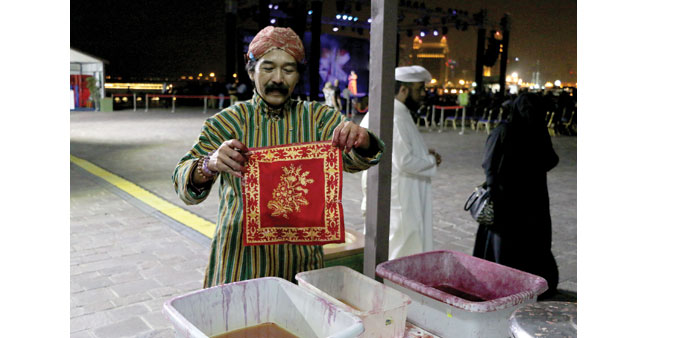By Umer Nangiana
Among songs, dances, traditional East Asian cuisine and cultural performances, the three-day ASEAN Festival at Katara also brought with it the world-famous Indonesian Batik. Dozens of people learnt how to create designs and patterns on a piece of cloth at a Batik workshop organised by the Indonesian embassy in Doha.
Conducted by veteran Batik maker and designer, RH Bambang Sumardiyono, who was flown in from Jakarta, the workshop provided the visitors with knowledge on Batik, its significance in Indonesian culture besides letting them try their own hands at creating patterns and designs on Batik.
Worn traditionally by the people of Eastern Asia for centuries, Batik is associated more with the diverse Indonesian culture.
Sumardiyono and his family have been promoting and protecting this cultural heritage for generations. “Batik is Indonesian cultural heritage and from each province in Indonesia, we have different patterns. The designs are made with all natural colours,” Sumardiyono says.
Each of the 34 provinces in Indonesia contributes its distinct style and design of Batik. And there are differences in patterns and designs further inside the provinces as they change according to the districts as well.
“If somebody is wearing a certain style from Eastern Java Island, we can easily tell. I am wearing one from Jakarta,” says the veteran Indonesian craftsman.
Batik is a technique of wax-resist dyeing applied to whole cloth, or cloth made using this technique. Batik is made either by drawing dots and lines of the resist with a spouted tool called a canting or by printing the resist with a copper stamp called a cap.
The applied wax resists dyes and therefore allows the artisan to colour selectively by soaking the cloth in one colour, removing the wax with boiling water, and repeating if multiple colours are desired.
A tradition of making batik is found in various countries including Nigeria, Singapore, India, Malaysia, Philippines and Sri Lanka, however, the batik of Indonesia is the most well-known.
Indonesian batik made in the island of Java has a long history of acculturation, with diverse patterns influenced by a variety of cultures, and is the most developed in terms of pattern, technique, and the quality of workmanship.
In 2009, Unesco designated Indonesian batik as a ‘Masterpiece of Oral and Intangible Heritage of Humanity.’
“I have been working on Batik for more than 29 years and this art of making Batiks and the business of selling them has been in my family for generations. I have been to 29 countries promoting Batik of Indonesia besides my own work,” says Sumardiyono.
He has organised workshops and classes for groups of people on how to make patterns on Batik and how to create one of their own. “In Japan, I made Batik patterned Kimono, the clothes traditionally worn by Japanese women.”
He runs a gallery at his home, which he established for the protection and promotion of Batik as national cultural heritage of Indonesia. It is doing really well, he says.
Having a degree in Philosophy, Sumardiyono has pursued his passion for Batik all his life. His two twin sons are also into the art of Batik. They are also getting regular education at schools as well, he says.
Many Indonesian batik patterns are symbolic. Infants are carried in batik slings decorated with symbols designed to bring the child luck, and certain batik designs are reserved for brides and bridegrooms, as well as their families, says the Indonesian artist.
Some designs are reserved for royalties, and even banned to be worn by commoners. Consequently, a person’s rank could be determined by the pattern of the batik he or she wore.
Batik garments play a central role in certain Javanese rituals, such as the ceremonial casting of royal batik into a volcano.
The popularity of batik in Indonesia has varied. Historically, it was essential for ceremonial costumes and it was worn as part of a kebaya dress, commonly worn every day. The use of batik was already recorded in the 12th century, and the textile has become a strong source of identity for Indonesians crossing religious, racial and cultural boundaries.
Batiks from Java can be distinguished by their general pattern and colours.
The most traditional type of batik, called batik tulis (written batik), is drawn using only the canting. The cloth need to be drawn on both sides and dipped in a dye bath three to four times. The whole process may take up to a year and yields considerably finer patterns than stamped batik.
The stall at the ASEAN festival also offered multiple patterns and styles of Batik for visitors to buy besides other traditional Indonesian handicraft.

DEMONSTRATION: RH Bambang Sumardiyono demonstrates pattern making on Batik. Photo by Umer Nangiana


